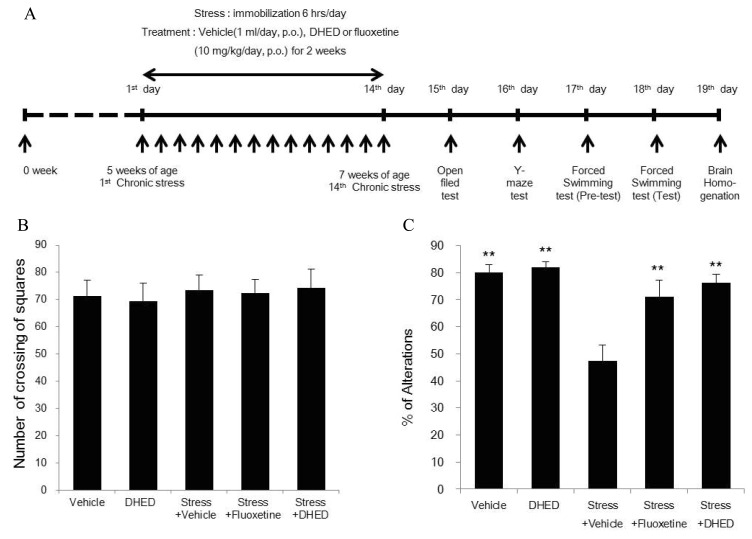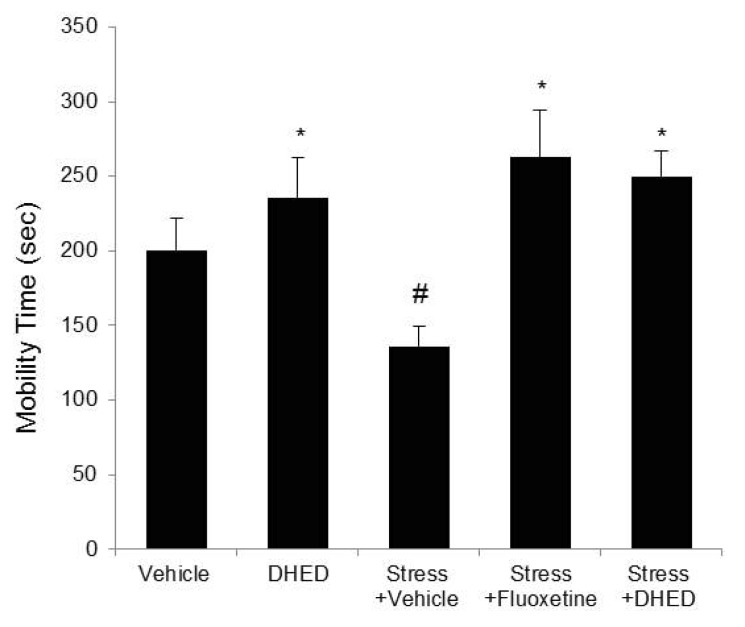Korean J Physiol Pharmacol.
2014 Feb;18(1):55-59. 10.4196/kjpp.2014.18.1.55.
Dehydroevodiamine.HCl Improves Stress-Induced Memory Impairments and Depression Like Behavior in Rats
- Affiliations
-
- 1Department of Pharmacology, College of Medicine, Seoul National University, Seoul 110-799, Korea.
- 2Korea Brain Research Institute (KBRI), Daegu 700-010, Korea. yhsuh@kbri.re.kr
- 3Braintropia Co. Ltd., Anyang 431-716, Korea.
- 4Department of Pharmacology, Gachon University of Medicine and Science, Incheon 406-799, Korea.
- KMID: 2285491
- DOI: http://doi.org/10.4196/kjpp.2014.18.1.55
Abstract
- Dehydroevodiamine.HCl (DHED) has been reported to prevent memory impairment and neuronal cell loss in a rat model with cognitive disturbance. We investigated the effect of DHED on memory impairment and behavioral abnormality caused by stress. We demonstrated that DHED can improve stress-induced memory impairments and depression-like behaviors by using open-field test, Y-maze test and forced swimming test. DHED treatment significantly recovered the decreases in the levels of neural cell adhesion molecule (NCAM) proteins caused by stress and the decreases in cell viability. Our results suggested that DHED is a potential drug candidate for neuronal death, memory impairment and depression induced by stress.
Keyword
MeSH Terms
Figure
Cited by 1 articles
-
Dehydroevodiamine·HCl enhances cognitive function in memory-impaired rat models
Ki Young Shin, Ka Young Kim, Yoo-Hun Suh
Korean J Physiol Pharmacol. 2017;21(1):55-64. doi: 10.4196/kjpp.2017.21.1.55.
Reference
-
1. McEwen BS, Eiland L, Hunter RG, Miller MM. Stress and anxiety: structural plasticity and epigenetic regulation as a consequence of stress. Neuropharmacology. 2012; 62:3–12. PMID: 21807003.
Article2. Hill MN. Introduction to the special issue on stress, emotional behavior, and the endocannabinoid system: a decade of research. Neuroscience. 2012; 204:1–4. PMID: 22348586.
Article3. Tran TT, Srivareerat M, Alkadhi KA. Chronic psychosocial stress triggers cognitive impairment in a novel at-risk model of Alzheimer's disease. Neurobiol Dis. 2010; 37:756–763. PMID: 20044001.
Article4. Alkadhi KA. Chronic stress and Alzheimer's disease-like pathogenesis in a rat model: prevention by nicotine. Curr Neuropharmacol. 2011; 9:587–597. PMID: 22654719.5. Djordjevic A, Djordjevic J, Elaković I, Adzic M, Matić G, Radojcic MB. Fluoxetine affects hippocampal plasticity, apoptosis and depressive-like behavior of chronically isolated rats. Prog Neuropsychopharmacol Biol Psychiatry. 2012; 36:92–100. PMID: 22019604.
Article6. Park CH, Kim SH, Choi W, Lee YJ, Kim JS, Kang SS, Suh YH. Novel anticholinesterase and antiamnesic activities of dehydroevodiamine, a constituent of Evodia rutaecarpa. Planta Med. 1996; 62:405–409. PMID: 8923803.7. Park CH, Lee YJ, Lee SH, Choi SH, Kim HS, Jeong SJ, Kim SS, Suh YH. Dehydroevodiamine.HCl prevents impairment of learning and memory and neuronal loss in rat models of cognitive disturbance. J Neurochem. 2000; 74:244–253. PMID: 10617126.
Article8. Park EJ, Suh YH, Kim JY, Choi S, Lee CJ. Long-lasting facilitation by dehydroevodiamine. HClof synaptic responses evoked in the CA1 region of rat hippocampal slices. Neuroreport. 2003; 14:399–403. PMID: 12634491.
Article9. Venero C, Tilling T, Hermans-Borgmeyer I, Schmidt R, Schachner M, Sandi C. Chronic stress induces opposite changes in the mRNA expression of the cell adhesion molecules NCAM and L1. Neuroscience. 2002; 115:1211–1219. PMID: 12453492.
Article10. Shin KY, Won BY, Heo C, Kim HJ, Jang DP, Park CH, Kim S, Kim HS, Kim YB, Lee HG, Lee SH, Cho ZH, Suh YH. BT-11 improves stress-induced memory impairments through increment of glucose utilization and total neural cell adhesion molecule levels in rat brains. J Neurosci Res. 2009; 87:260–268. PMID: 18712849.
Article11. Bisaz R, Sandi C. Vulnerability of conditional NCAM-deficient mice to develop stress-induced behavioral alterations. Stress. 2012; 15:195–206. PMID: 21939373.
Article12. Shichi K, Fujita-Hamabe W, Harada S, Mizoguchi H, Yamada K, Nabeshima T, Tokuyama S. Involvement of matrix metalloproteinase-mediated proteolysis of neural cell adhesion molecule in the development of cerebral ischemic neuronal damage. J Pharmacol Exp Ther. 2011; 338:701–710. PMID: 21602423.
Article13. García-Bueno B, Caso JR, Pérez-Nievas BG, Lorenzo P, Leza JC. Effects of peroxisome proliferator-activated receptor gamma agonists on brain glucose and glutamate transporters after stress in rats. Neuropsychopharmacology. 2007; 32:1251–1260. PMID: 17119541.
Article14. Shin KY, Lee GH, Park CH, Kim HJ, Park SH, Kim S, Kim HS, Lee KS, Won BY, Lee HG, Choi JH, Suh YH. A novel compound, maltolyl p-coumarate, attenuates cognitive deficits and shows neuroprotective effects in vitro and in vivo dementia models. J Neurosci Res. 2007; 85:2500–2511. PMID: 17600377.15. Porsolt RD, Le Pichon M, Jalfre M. Depression: a new animal model sensitive to antidepressant treatments. Nature. 1977; 266:730–732. PMID: 559941.
Article16. Chiou SH, Chen SJ, Peng CH, Chang YL, Ku HH, Hsu WM, Ho LL, Lee CH. Fluoxetine up-regulates expression of cellular FLICE-inhibitory protein and inhibits LPS-induced apoptosis in hippocampus-derived neural stem cell. Biochem Biophys Res Commun. 2006; 343:391–400. PMID: 16545775.
Article17. Freire-Garabal M, Nuñez MJ, Losada C, Pereiro D, Riveiro MP, González-Patiño E, Mayán JM, Rey-Mendez M. Effects of fluoxetine on the immunosuppressive response to stress in mice. Life Sci. 1997; 60:PL403–PL413. PMID: 9199489.
Article18. Mizoguchi K, Yuzurihara M, Ishige A, Sasaki H, Chui DH, Tabira T. Chronic stress induces impairment of spatial working memory because of prefrontal dopaminergic dysfunction. J Neurosci. 2000; 20:1568–1574. PMID: 10662846.
Article19. Gersner R, Gordon-Kiwkowitz M, Zangen A. Automated behavioral analysis of limbs' activity in the forced swim test. J Neurosci Methods. 2009; 180:82–86. PMID: 19427533.
Article20. Tsoory M, Guterman A, Richter-Levin G. Exposure to stressors during juvenility disrupts development-related alterations in the PSA-NCAM to NCAM expression ratio: potential relevance for mood and anxiety disorders. Neuropsychopharmacology. 2008; 33:378–393. PMID: 17429411.
Article21. Kajta M, Trotter A, Lasoń W, Beyer C. Effect of NMDA on staurosporine-induced activation of caspase-3 and LDH release in mouse neocortical and hippocampal cells. Brain Res Dev Brain Res. 2005; 160:40–52.
Article
- Full Text Links
- Actions
-
Cited
- CITED
-
- Close
- Share
- Similar articles
-
- Dehydroevodiamine·HCl enhances cognitive function in memory-impaired rat models
- Chrysin Attenuates Oxidative Stress to Alleviate Sevoflurane-Induced Cognitive Impairments in Aged Rats
- Memory Impairment in Dementing Patients
- The Effects of Astragalus Membranaceus on Repeated Restraint Stress-induced Biochemical and Behavioral Responses
- A Study of Factors Influencing Subjective Memory Complaints among Community Dwelling Elderly




